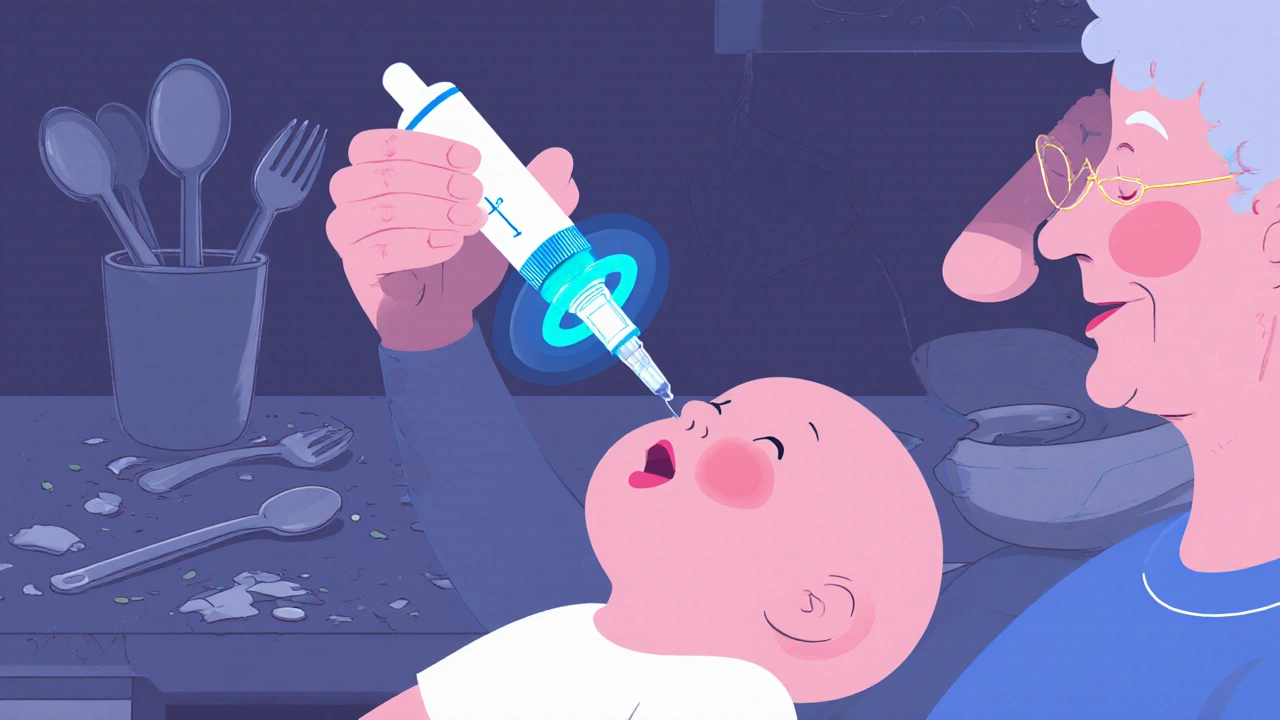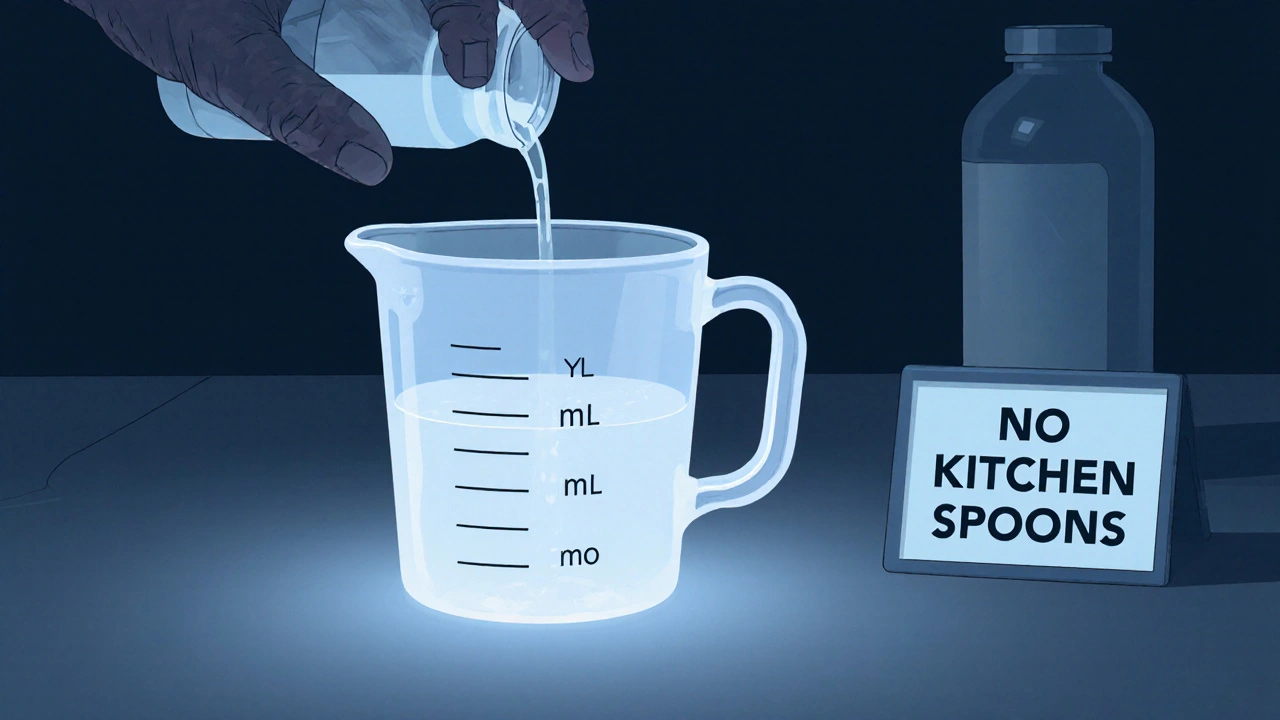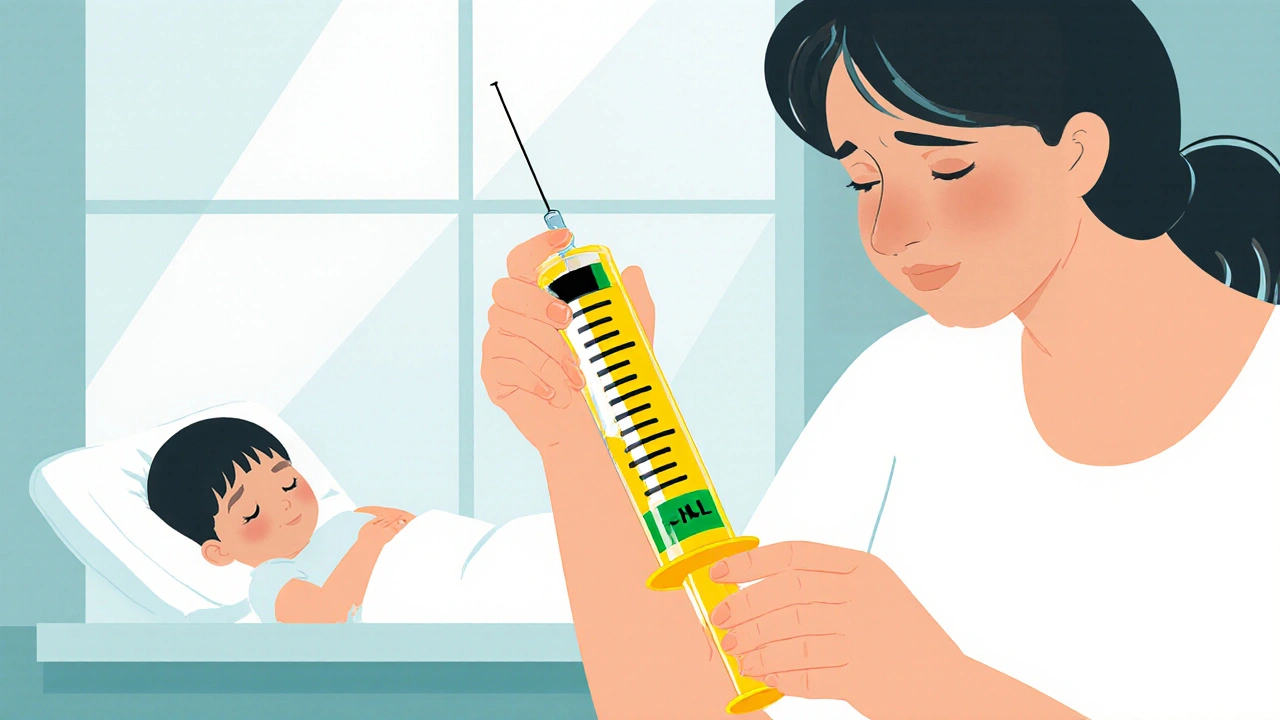Medication Dosing Calculator
Convert & Verify Your Dose
Enter your prescribed dose in milliliters (mL) to see equivalents in teaspoons (tsp) and tablespoons (tbsp), plus safety indicators.
Dose Conversion
Safety Verification
Getting the right dose of medicine isn’t just about reading a label. It’s about seeing it clearly-especially when you’re giving medicine to a child, an elderly parent, or managing it yourself under stress. That’s where visual dosing aids come in. These aren’t fancy gadgets. They’re simple tools-syringes, droppers, cups-with smart design features that make it impossible to guess how much to give. No more squinting at tiny lines, no more confusing decimals, no more panic when the clock is ticking.
Why Visual Dosing Aids Matter
In 2025, medication errors still cause over 1.5 million preventable injuries in the U.S. every year. A big chunk of those? Wrong doses of liquid medicine. Parents mixing up milliliters and teaspoons. Nurses misreading syringe graduations. Elderly patients pouring from bottles without clear markers. These aren’t rare mistakes. They happen daily in homes and hospitals alike. Studies show that when people use visual dosing aids, error rates drop by more than half. One 2018 study tested radiologists giving epinephrine during simulated allergic reactions. Groups using visual aids made errors in just 18.2% of cases. Groups without? 40%. That’s a 54.5% drop in mistakes. And it wasn’t just fewer errors-it was faster. With visual aids, they gave the dose in 97 seconds. Without? 152 seconds. That’s over a minute saved in a life-or-death situation.How Syringes Are Designed for Safety
Not all syringes are created equal. Standard plastic syringes from the pharmacy often have tiny, faded lines. A 2.5 mL mark might look like 2.8 or 3.0 if you’re tired, stressed, or in low light. That’s why medical-grade visual dosing syringes exist. These syringes have:- **Bold, high-contrast markings**-black numbers on a bright yellow or white background
- **Larger, simplified scales**-only key doses shown (like 0.5 mL, 1.0 mL, 2.0 mL), not every 0.1 mL
- **Color zones**-green for safe dose, yellow for caution, red for overdose risk
- **Tactile ridges**-you can feel the 1 mL mark even if you can’t see it
Droppers That Show You When You’ve Got It Right
Droppers are common for infants, especially for vitamins, fever reducers, or seizure meds. But traditional glass droppers? They’re terrible for accuracy. The liquid clings to the sides. You squeeze too hard. You lose half of it. Modern visual dosing droppers fix this:- **Clear measurement windows**-you see the liquid level without tilting
- **Colored indicators**-a blue ring appears when you’ve drawn the correct dose
- **Anti-drip tips**-no dripping after you stop squeezing
- **Built-in calibration**-no need to eyeball from a bottle

Measuring Cups and Spoons: The Forgotten Tool
Kitchen spoons are dangerous. A teaspoon isn’t 5 mL. A tablespoon isn’t 15 mL. And “a capful” is pure guesswork. Visual dosing cups change that. They’re made of sturdy plastic, with:- **Raised, easy-to-read numbers**-not printed, but molded into the plastic
- **Dual units**-mL and teaspoons clearly labeled side by side
- **Spout design**-no spills when pouring
- **Non-slip base**-stays put on a counter
Who Benefits Most?
These tools aren’t just for “special cases.” They’re for anyone who:- Administers medicine to a child under 5
- Manages multiple daily meds for an elderly relative
- Takes liquid medication themselves and has trouble reading small print
- Lives in a home where lighting is poor or stress is high
Limitations and What They Can’t Fix
Let’s be real: visual aids aren’t magic. In the same study where errors dropped from 40% to 18.2%, they still happened. Why? Because the biggest mistake wasn’t misreading the syringe-it was giving the shot into the wrong place. Self-administration errors were common, even with perfect visuals. Visual dosing aids reduce calculation errors. They don’t fix:- Wrong route (giving oral medicine by injection)
- Wrong medication (grabbing the wrong bottle)
- Wrong patient (giving someone else’s medicine)

How to Get Started
You don’t need a prescription. Here’s how to pick the right tools:- **Match the tool to the medicine**-use a syringe for antibiotics, a dropper for vitamins, a cup for syrup
- **Look for color zones**-green = safe, red = danger
- **Check the scale**-only key doses shown, no clutter
- **Buy from reputable brands**-BD, CareFusion, Medline, or UK pharmacy chains like Boots or LloydsPharmacy
- **Store them with the medicine**-keep the syringe in the same box as the bottle
What Experts Say
Radiologists in the 2018 study were split: some had never used visual aids before. After one simulation, 97.8% said they’d use them again. 87% said it would cut their response time in real emergencies. Pediatricians in resource-limited areas call visual dosing tools “lifesavers.” One nurse in Malawi told researchers: “Before these syringes, we lost kids because we gave too much. Now, we don’t even need to calculate. We just match the color.” The Joint Commission and WHO now recommend visual dosing aids as part of standard safety protocols in hospitals. In the UK, NHS guidelines encourage their use in community pharmacies for high-risk medications.Final Thought: Simplicity Saves Lives
Medicine isn’t supposed to be complicated. If you need a calculator to give your child a dose, the system has failed. Visual dosing aids bring the math into sight. They turn uncertainty into confidence. They turn fear into action. You don’t need to be a doctor to use them. You just need to care enough to choose the right tool. And that’s the first step to safety.Are visual dosing aids only for children?
No. While they’re especially helpful for kids, they’re just as important for older adults, people with vision problems, or anyone managing complex medication schedules. Seniors often misread tiny labels, and visual aids remove that barrier. A syringe with bold numbers helps someone with arthritis or poor eyesight give insulin or blood pressure meds accurately.
Can I use a kitchen spoon instead of a dosing tool?
Never. A standard teaspoon holds anywhere from 3 to 7 mL-not the 5 mL it’s supposed to. A tablespoon can be 12 to 20 mL. Using kitchen spoons for medicine is one of the top causes of pediatric overdoses. Always use a proper dosing syringe, dropper, or cup marked in milliliters.
Do I need training to use visual dosing aids?
No formal training is needed. These tools are designed to be intuitive. The color zones and large markings let you understand the dose at a glance. But it helps to practice once with a pharmacist. They can show you how to draw the correct amount and confirm the markings match your prescription.
Where can I buy visual dosing tools in the UK?
You can find them at most major pharmacy chains like Boots, LloydsPharmacy, and Superdrug. Look in the children’s medicine or chronic care section. Some online retailers like Amazon UK also stock them, but check the brand to ensure it’s medical-grade. Ask the pharmacist-they often keep them behind the counter for high-risk meds.
Do insurance or the NHS cover these tools?
Generally, no. They’re considered low-cost safety tools, not medical devices requiring reimbursement. But many NHS community pharmacies provide them for free if you’re on a long-term medication regimen, especially for children or elderly patients. Always ask-some clinics have them on hand for patients who need them.
Can visual dosing aids prevent all medication errors?
No. They prevent calculation and measurement errors, which are common, but not all errors. Mixing up medicines, giving the wrong route (oral vs. injection), or giving someone else’s dose still happens. Visual aids are a powerful tool, but they work best when combined with clear labeling, separate storage, and double-checking by another person.


Comments (13)
Dave Pritchard
November 19, 2025 AT 10:27These visual dosing tools are a game-changer. I’ve seen my aunt struggle for years with her insulin syringe-tiny lines, bad lighting, shaky hands. She switched to a BD syringe with the green zone and now she’s got peace of mind. No more midnight panic calls to her kids. Simple, smart, life-saving stuff.
Everyone should have access to these. They’re not luxury items. They’re basic safety gear.
kim pu
November 21, 2025 AT 01:19ok but like… who the hell designed these syringes? did they get paid in glitter? green = safe? red = doom? what is this, a toddler’s crayon box? i get it’s meant to be intuitive but now i’m convinced the medical industrial complex is just trying to make us think we’re in a video game. also why is everything so damn colorful? my eyes are tired.
also who said ‘color zones’ wasn’t a marketing gimmick? i bet the FDA got bribed with a free dropper.
malik recoba
November 21, 2025 AT 23:31i just want to say thank you for this. my grandma uses a dropper now for her seizure meds and she says she can finally do it herself without crying. she’s 78 and has bad eyesight. the blue ring thing? she calls it her ‘magic circle’. i cried when she told me that.
also i messed up and bought a kitchen spoon once. never again. so dumb. these tools cost like 5 bucks. it’s not even a choice anymore.
Sarbjit Singh
November 22, 2025 AT 07:02Bro this is life changing 😊 I’m from India and we don’t have these easily here. My cousin’s baby was on liquid antibiotics and we were using a spoon. One day she got sick again because of wrong dose. Now I’m ordering these from Amazon India. Worth every rupee. Thanks for sharing! 🙏
Angela J
November 22, 2025 AT 11:59wait… so you’re telling me the government and big pharma didn’t want us to have these tools? because if they made them standard, people wouldn’t need doctors as often? and if people didn’t need doctors… what happens to the trillion-dollar drug industry? hmmmm…
why are these only sold in pharmacies? why not in Walmart? why not free? why are they so expensive? this smells like a cover-up. someone’s hiding the truth. i’ve seen the documents. the syringes are supposed to be free. they’re not. they’re selling us safety like it’s a subscription service. 🕵️♀️
Sameer Tawde
November 22, 2025 AT 23:37Just got one for my kid’s fever meds. Took 30 seconds to use. No math. No stress. Just fill to the line. Done.
Stop using spoons. Seriously. It’s not worth the risk. These cost less than your morning coffee. Do the right thing.
Jeff Hakojarvi
November 24, 2025 AT 09:55I work in a pediatric ER and I’ve seen too many kids come in because someone used a kitchen spoon. One time, a mom gave her 2-year-old 15mL of acetaminophen thinking it was a tablespoon. She didn’t know the difference.
These tools? They’re not optional. They’re essential. I hand them out to every family I can. Even if they say ‘I’m fine.’ I say ‘try this once.’ They always come back saying ‘why didn’t we do this sooner?’
And yeah, they’re cheap. Like, $4 cheap. That’s less than a parking ticket.
Timothy Uchechukwu
November 25, 2025 AT 03:58in my country we dont need these fancy toys. we give medicine with a spoon and trust god. why do you westerners make everything so complicated? we dont have your money or your hospitals but we dont lose our children. you overthink everything. this is just another way to sell plastic. you think a color zone saves lives? we have faith. and we dont need a dropper to know when to stop pouring.
your system is broken. you need a tool for everything. we need nothing.
Ancel Fortuin
November 25, 2025 AT 13:23so let me get this straight. you’re telling me that after centuries of human medicine, we suddenly need a color-coded syringe with a ‘feel the ridge’ feature to not kill people? who designed this? a cartoonist? why not just put a QR code on the bottle that says ‘DO NOT GIVE 10ML’?
and why is no one talking about how these tools are probably made in sweatshops in China? i bet the green zone is painted with lead-based ink. i’m not buying this. this is a distraction. the real problem is that we don’t regulate medicine labels properly. fix that. not the syringe.
also… who funds this article? i smell a pharmaceutical ad disguised as ‘safety advocacy’.
Hannah Blower
November 26, 2025 AT 16:50Let’s be honest: this isn’t about safety. It’s about the commodification of vulnerability. We’ve turned parenting and elder care into a performance of precision. Now you need a color-coded, tactile, glow-in-the-dark syringe to prove you’re a ‘responsible caregiver.’
Where’s the radical empathy? Where’s the systemic change? Why are we not demanding that medicine labels be standardized in universal visual language? Why are we letting corporations dictate the aesthetics of care?
These tools are a Band-Aid on a bullet wound. And they’re branded. And they’re profitable. And we’re all complicit in the aestheticization of trauma.
Also, who decided green = safe? That’s a culturally loaded color association. What about colorblind people? Did anyone test this with achromatopsia? No. Of course not.
Ronald Stenger
November 28, 2025 AT 00:39So we’re giving kids colored syringes now? What’s next? A sticker that says ‘you’re doing great’ when you get the dose right? This is pathetic. We used to teach people to read. Now we dumb down medicine so people don’t have to think. This isn’t progress. This is surrender.
And why are we letting corporations control what ‘safe’ looks like? If you can’t read a syringe, maybe you shouldn’t be giving medicine. That’s not a design flaw. That’s a personal responsibility issue.
Also, who’s paying for these? Taxpayers? Because I didn’t vote for this.
Samkelo Bodwana
November 29, 2025 AT 04:27I’ve been thinking about this a lot. I’m from South Africa. In townships, people often use whatever container they have - a medicine bottle cap, a shot glass, even a plastic lid from a yogurt cup. We don’t have access to these tools. But I’ve seen community health workers make their own visual aids with colored tape and permanent markers. They draw lines, they use red for danger, green for go.
It’s not perfect. But it works. And it’s human. It’s not corporate. It’s community.
So maybe the real question isn’t ‘how do we get more syringes?’ but ‘how do we empower people to make their own safety tools?’
These branded tools are great. But they’re not the only solution. And we shouldn’t let the market decide who gets to be safe.
Emily Entwistle
November 29, 2025 AT 09:37OMG YES 😍 I just bought the glowing cup for my toddler’s antibiotics. It’s so cute and the line glows under the kitchen light?? I swear I’ve never felt so proud of a $6 plastic cup. My husband said I’m obsessed. I said ‘you try giving medicine with a spoon at 2am after 3 hours of no sleep.’ 🤫✨
Also, the dropper with the blue ring? I showed my mom. She cried. Said she wished she had this when she raised me. 🥺❤️